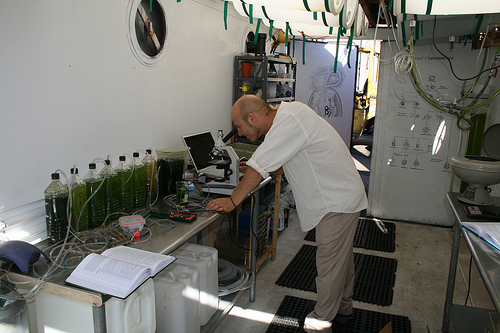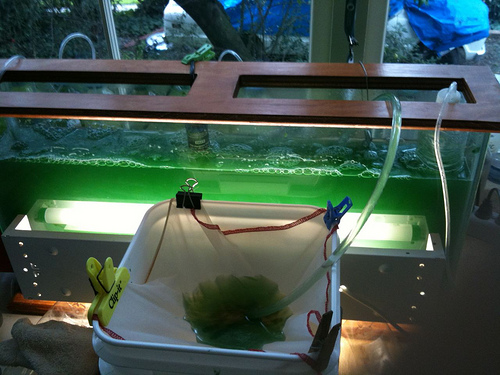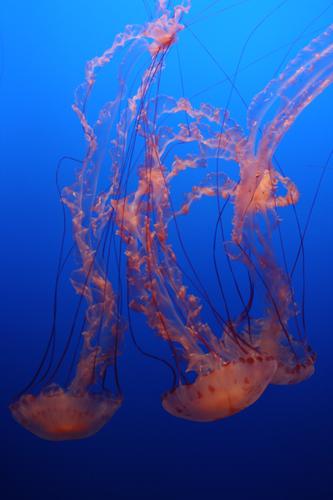Microscopic spinning orbs and spirals of green goo are the answers to our planet's energy crisis and arable land shortage. At least that's what Aaron Baum, a 40-year-old Harvard graduate and Stanford PhD, has concluded.
And Baum should know. After a mid-life crisis of sorts, he spent months researching the types of science that would most benefit the world and concluded that algae are it. Now, he wants to share his passion with the public by creating communities of people with their own algae farms. Imagine that – you can have a personal algae tank that provides fresh, ultra-nutritious food on a year-round basis.
Baum is a research consultant for NASA's OMEGA project, whose mission is to create massive amounts of algae for biofuel, fertilizer and food. The San Rafael, California algae-phile knows not everyone has access to professional grade equipment – which can cost tens of thousands of dollars – so Baum has started teaching seminars on how to raise spirulina inexpensively and in one's own home. The day-long workshops cost $150 and he'll also provide you with a kit that includes a tank, spirulina starter stock, a nutrient mix and other equipment for $200. Through these workshops, Baum hopes to continue forming a collaborative community that shares knowledge about algae farming.
The seminars grew out of Baum's first venture in algae. In 2008, he created what he says was the world's first communal algae farm. The project was based in Berkeley and consisted of more than a dozen 55-gallon tanks of algae. It eventually got so massive that it would've required full-time staff, so Baum closed it down when he traveled around the world last year to attend algae workshops and visit algae farms. When he returned, he thought it would be more manageable to have the farms in people's homes. I talked with him about his adventures in algae, and his plans for the future
Alice Chen: How did you get interested in algae?
Aaron Baum: As a scientist, I'm completely committed to doing good things for the environment. I earned my Phd in applied physics from Stanford in 1997 and worked for several years in Silicon Valley as a program manager on technologies I developed in graduate school. I realized I was working my butt off to make computer chips run faster. I kind of lost faith in what I was doing.
I dropped out of that field, worked as an artist for several years and realized I miss science — the intellectual challenge and making contributions and changing peoples' lives. I decided to get back into science on my own terms.
I thought about it for a long time and decided I wanted to work in a field where I could be sure I was doing something good for the world. I started doing a lot of research four years ago and after a few months, algae started to stick up out above everything else. Back then if you searched for algae, what came up was how to kill algae and how bad it was because of algae blooms. That was happening for a while but now it's exponentially worse. I started working in that area. Now if you search for algae (online), about half of what you find is good.
AC: What's so great about algae?
AB: Algae is a way to grow really high quality food in a small area, on the surface of a body of water or in wastewater. Or you can grow algae in dilute urine which is an easy way to get the right nutrients and reduce your impact on the environment.
Most marine biologists consider that the number one danger to marine life is eutrophication, an excess of nutrients in the water from agricultural runoff due to application fertilizer. When it hits the ocean or lake, there are massive algae blooms. When they decay, they wipe out oxygen and everything dies.
If you can find a way to keep nutrients out of water, you reduce the size of dead zones. You can create controlled algae blooms, harvest algae and eliminate nutrients that way. Or you can take wastewater, give it to algae directly and absorb nutrients. You come out with clean water, fuel, food, fertilizer and extra oxygen. And on a small scale in your own house if you grow it in dilute urine, you reduce the fertilizer load on the local ecosystem.
AC: Tell me about algae as food. Why are people so into it?
AB: The idea was first proposed in the 1930s in Germany. They were trying to develop it for growing food. You can grow a lot of food in a small area. It's extremely nutritious on a gram-for-gram basis. You can mix it in with other food. It didn't take off until spirulina in the 1970s. Now there's chlorella.
Normally you get spirulina in a powder or pill form. It's grown in large outdoor ponds normally, and you sieve it out of water. It's kind of special. It grows in corkscrew filaments making it relatively easy to strain out of water using a special fabric. Most other kinds of algae are too small and roundish, very difficult to filter.
Algae as a food is extremely healthy. It's high in complete protein, antioxidants, omega-3 fatty acids, and it's effective against infections. It has defenses against viruses and you can acquire defenses as well. It's good to protect against environmental toxins. There were dozens of experiments where they fed rats a regular diet and another group with spirulina. They exposed them to mercury, lead, pesticides, radiation and mutagens and found that spirulina-eating rats do much better.
In powder form, spirulina's great, but when you want to eat a blueberry, you don't want it powdered. You want it fresh. You can eat fresh spirulina that's basically alive. It tastes better.
AC: What does it taste like?
AB: The problem with most algae is it tastes like seaweed. A lot of people are not turned on by that taste. I think it's really good in certain dishes. When you eat it live, fresh, the taste is much lighter, creamy, and buttery. You can spread it on crackers. We mix it with brown rice and guacamole so it's vegan. The easiest way is in carrot juice.
AC: Is anyone else doing what you're doing?
AB: We're at the very beginning of growing it. A few people have worked on it. Some people in France grow spirulina on a small scale in their house. Outside of France, there's been very little work. I'm not aware of anyone in the U.S. working on it other than us.
AC: Why haven't more people already started growing algae in their homes?
AB: There are technical barriers. You need to grow live spirulina. You need a seed reactor, a nutrient mix to put in the water and a special cloth. You must maintain proper balance between acidity and alkalinity, and the proper temperature. What I'm doing is putting together a kit to provide live spirulina.
AC: How is this a communal project?
AB: I'm starting out by building the community and showing people how they can do it themselves. We'll do it together and share information through our website.
Previously we built a whole algae lab all based on volunteer labor. We built it for about 1,000 times less money than what we spend in places like NASA. What we're aiming to do is cultivate algae based on free material. We grow algae and are investigating it as fertilizer, biofuel, and growing it in dilute urine.
We'd like to create an international network of people growing all kinds of algae in their homes in a small community scale, sharing information, doing it all in an open source way. We'd be like the linux of algae – do-it-yourself with low-cost materials and shared information.
I get emails from all over world. There's been a huge wave of interest in algae, driven by biofuels and by the growing awareness of the lack of farmland. If you want to make new farmland, you have to destroy ecosystems. The biggest impact humans have on the world is through agriculture. If we want to grow more food so people can eat better, we either destroy the last remaining ecosystems on the planet or find a new way to do things.

AC: What's the market like for spirulina?
AB: The world consumes about 100,000 tons of spirulina a year. It's used for animal feed and it's a nutraceutical (that is, a food that provides health benefits). It's kind of expensive, usually about $80 per pound for powder. It's a very nutrient dense food. When I eat spirulina – I eat vegan – I don't have cravings for meat or sugar. Food is more satisfying when it has spirulina. I eat a lot, 15 grams a day. Most people would consider 5 grams a day to be fairly high. If you're eating 10 grams a day, you're spending about $200 a year on it.
AC: How did you transition into algae as a career?
AB: I got interested in algae and decided to create an algae farm project at Burning Man in 2007. I got together a community of people and we created an installation on a trailer. We had 16 bioreactors with live algae that was eating the exhaust of a generator. They grew great – it was very successful. We had a lot of educational material. There were big posters jammed full of text explaining what we were doing and why it was interesting.
I've worked at the Exploratorium. They'll tell you that anything beyond one to two sentences, there's no way you're going to get anyone in the public to read anything more than that. On the night of the Burn, the craziest night of all with partying and dancing, I went to the installation. We had forgotten to turn the lights on. In the dark, I was surrounded by people all using headlamps, leaning close and reading every single word we'd written. As soon as they knew I was part of it, they started peppering me with questions. A guy from NASA was inspired by this project and then joined the OMEGA project. And then he gave me a call.
AC: What are you doing for NASA?
AB: We're developing large-scale systems that are combining biofuel and fertilizer production with wastewater treatment and production of fresh air and fresh water. We're using large membrane enclosures floating in bodies of water. It's a low-energy, low-resource way of growing algae.
One budding thing of NASA technology – we're working on a clever way of removing algae from water.
We're focused on the biofuel aspect at NASA. For biofuel, you want a species that produces a lot of oil. Many species of algae can produce huge amounts of oil — they can be more than 50 percent oil by weight, compared to normal plants that only produce a few percent.
Algae can produce about 100 times more than typical oil plants like soybeans, on a per acre basis. You can grow enough algae to replace all of the fossil fuel in an area that's small enough to be manageable. You don't need to use farmland, there's not much remaining in the world ready to be used, and you don't need fresh water. The nice thing about algae is while they cleans water and air, they can produce very valuable things like fuel, fertilizer and food. They're precursers for bioplastics, cosmetics and medicines.
It's a new kind of farming, potentially very low impact and sustainable.
AC: So what's your vision — to see every household have algae?
AB: I don't see why not. It should be easier than a vegetable plot. Algae is such a super food. It's so productive on a daily basis that with one tank in a window you can significantly supplement the diet of one person. If you use a whole window, you could probably do two to three tanks year round and have even more. Every day you could be eating algae.
Algae is an incredible resource we haven't tapped into. Human beings haven't gone there yet because it's microscopic. I didn't know what algae were until quite a bit later in life. They don't really teach you about it in school. It produces approximately 70 percent of the oxygen we breathe. It's the basis of 95 percent of life that's in oceans.
Even people with no dirt can grow fresh food for themselves. If you're in an apartment complex on the 25th floor, you can still grow fresh food.
##
Similar Stories:
I Made an iPad eBook In One Weekend (And You Can Too!)
A Factory in Every Home (a desktop factory that can reproduce itself)
Aquaponic Transformation (growing fish & food in a symbiotic system)














